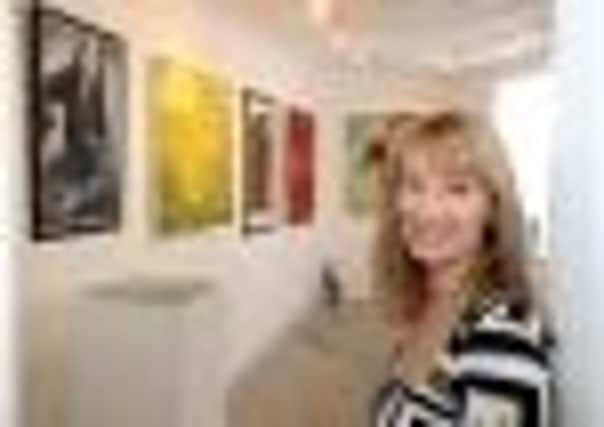Art and commerce


Well, an estimated 10,000 exhibiting artists later, the Cupola Gallery is celebrating its 21st birthday – in the same premises but now expanded into four art-packed rooms, with a fountain-filled sculpture garden, a framing shop across the road, a staff of five, educational courses and workshops, and free chocolate cake on Saturdays.
Karen Sherwood is a feisty, inexhaustibly positive woman with an exuberant laugh that stops dogs in their tracks. Her CV describes her as “a highly networked arts professional”, but she’s none the worse for that. She’s spent half her life running this gallery, in Hillsborough, an area of Sheffield that’s not, on the face of it, a hotbed of contemporary art.
Advertisement
Hide AdAdvertisement
Hide AdThe back door to the upstairs room where she’s hanging pictures when I arrive offers a grandstand view of Sheffield Wednesday’s football ground. At one time, the room doubled as Karen’s living room; she cleared away the dining table and sofa every morning before customers arrived.
She had just graduated with a Fine Art degree from Sheffield Polytechnic (now Sheffield Hallam University) when she set up the gallery in a former haberdasher’s shop measuring 14ft by 12ft. From the start she took a crusading attitude to stock – “strong and gutsy rather than pretty”, not just easy-on-the-eye Derbyshire landscapes, Ashford-in-the-Watercolours as they’re known.
She also took a pragmatic approach to payment. Long before the Arts Council launched its Own Art scheme – spreading the cost of buying a work over 10 months with an interest-free loan – Karen had customers who paid her in instalments of £2.50 a week. She once framed a picture for a pork butcher and, instead of cash, he gave her a slab of parkin, an egg custard and a pack of pork bits in return.
“Since then I’ve had people getting out of Porsches when they come to the gallery,” she says. “They say they can’t afford art. Well, that’s because they’ve bought the Porsche. When people say ‘I can’t afford it’, I say ‘You choose not to afford it.’
Advertisement
Hide AdAdvertisement
Hide Ad“There are plenty of people with money who would never buy art in a million years. Passion buys art. People need to move beyond function. I’ve had customers who say: ‘We’re going to have a painting not a holiday this year.’ And I’ve got one customer who’s pushing 80. She doesn’t have a washing machine and hand washes her clothes so she can spend the money on artworks.”
Ninety-eight per cent of her customers – from all over Yorkshire, and as far as London and Scotland – come back for more, some since the year she opened. “I always say the other two per cent have either died or don’t live in this country.” Her 1991 enthusiasm seems undimmed. Busy with more projects two years ago, she toyed with giving up the gallery, “but that would have been like chopping a limb off.”
The Cupola’s four rooms are packed with art, ranging from miniature photographs at £10 to sculptures at £6,500. The most expensive picture she’s sold cost £5,500. All her stock is contemporary, mostly by living artists (“a couple have died on me”). There are landscapes, abstracts, bold stuff, wacky stuff, sculpted dodos, a row of teacups made from wire, hundreds of things.
I catch an exhibition of miniatures. The artists were challenged to create works no bigger than a £20 note. Karen is good at bright ideas. One exhibition was completely lit by candles to create atmosphere. Another was called The £30 Show – nothing costing more than that. Another was Vices and Virtues. “We rang a churchman to ask what the different virtues and vices are, and he said: ‘Well, I know the vices, but I’m not sure about the virtues. We deal more with the vices’.”
Advertisement
Hide AdAdvertisement
Hide AdShe stops banging nails in the wall and reflects on fashionability and the recession: “Art galleries can become an exclusion zone. Curators have become the DJs of the art world, sometimes more important than the art itself. I remember someone calling me a ‘gallerist’. I said: ‘What? Do you call someone who owns a shop a ‘shoppist’?’
“When I started, if people said they were artists, they were on the dole. Now I know lots who make a living from their work.” She acknowledges, though, that artists who have worked mostly in the public sector may now suffer from government cuts.
I wonder about the “10,000 artists” claim? At any one time, the gallery stocks work by 300 artists – “all living artists; I don’t take them if they’re already dead” – so with, say, a different exhibition every month, the 10,000 figure looks, if anything, an underestimate. “Our new show is by an artist who lives in the Pyrenees – Francis Berthault – but we also have work by artists who live 300 yards away from the gallery.”
And the name? Why Cupola? As she said when she opened: “Calling it the Hillsborough Gallery sounded like we’re showing football posters. So I went through a Sheffield street directory and found there was a street called Cupola, to do with furnaces, which seemed appropriate for the city.”
Cupola Gallery, 0114 285 2665; www.cupolagallery.com, is at 178a Middlewood Road, Sheffield S6 1TD. Hauts Monts exhibition by Francis Berthault until May 27.